Exploring Christianity: An Annotated Bibliography of Top Sources
VerifiedAdded on 2023/06/10
|5
|1268
|229
Annotated Bibliography
AI Summary
This annotated bibliography provides a compilation of ten sources that explore various facets of Christianity. The sources cover topics such as the rise of Pentecostal and Charismatic movements in Canada, the history of Christian missions and their impact on globalization, and the evolution of Christian ideals from beauty to agony. Furthermore, it delves into the anthropology of Christianity, the economics of sacrifice within the religion, its history in sub-Saharan Africa, and its role in controlling neglected tropical diseases. The bibliography also examines the post-traumatic growth following Jesus' death and the backgrounds of early Christianity, including Roman, Greek, and Jewish influences. Finally, it explores the ongoing transformations within Christianity and the shifting authorities that shape its values.
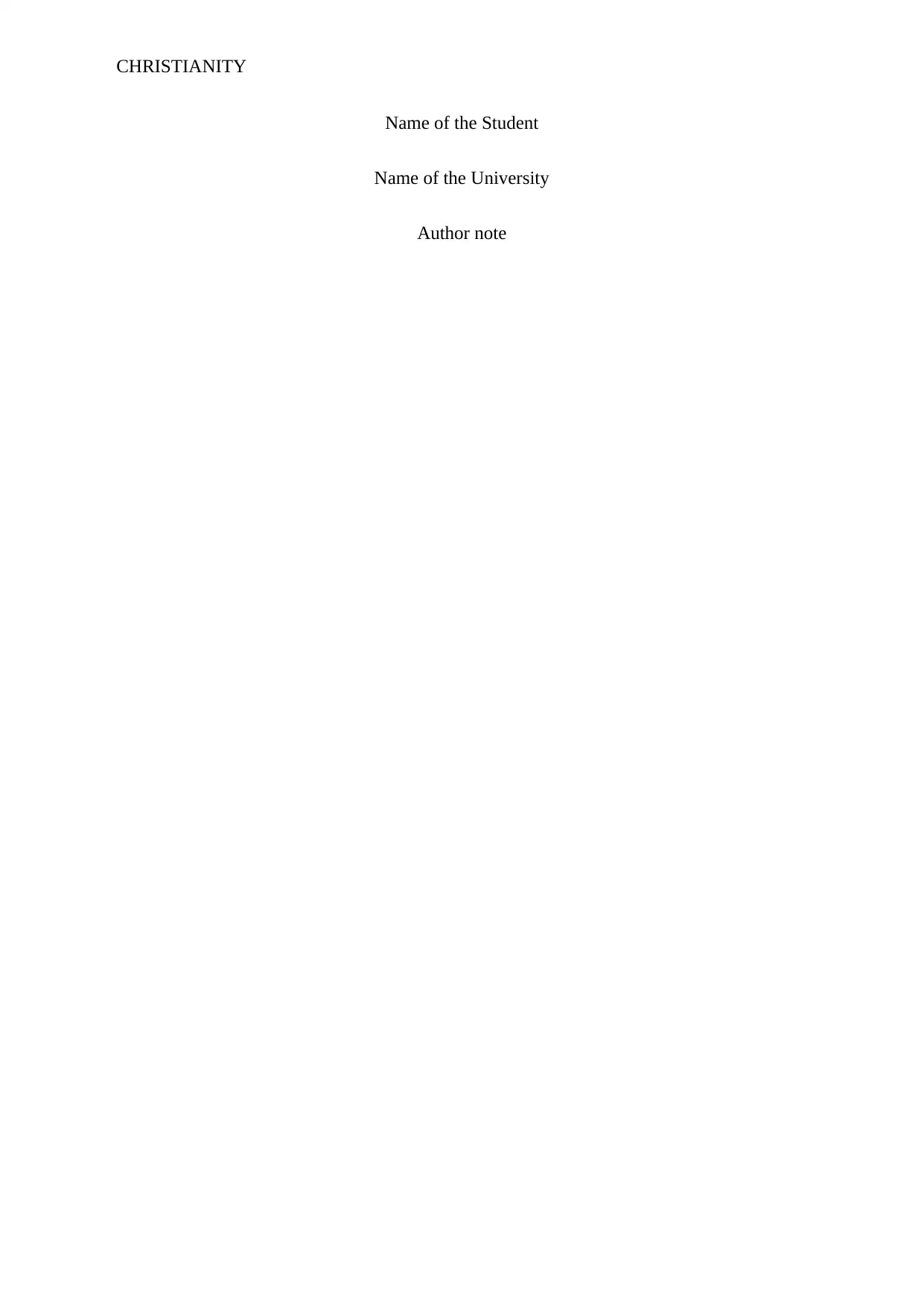
CHRISTIANITY
Name of the Student
Name of the University
Author note
Name of the Student
Name of the University
Author note
Paraphrase This Document
Need a fresh take? Get an instant paraphrase of this document with our AI Paraphraser
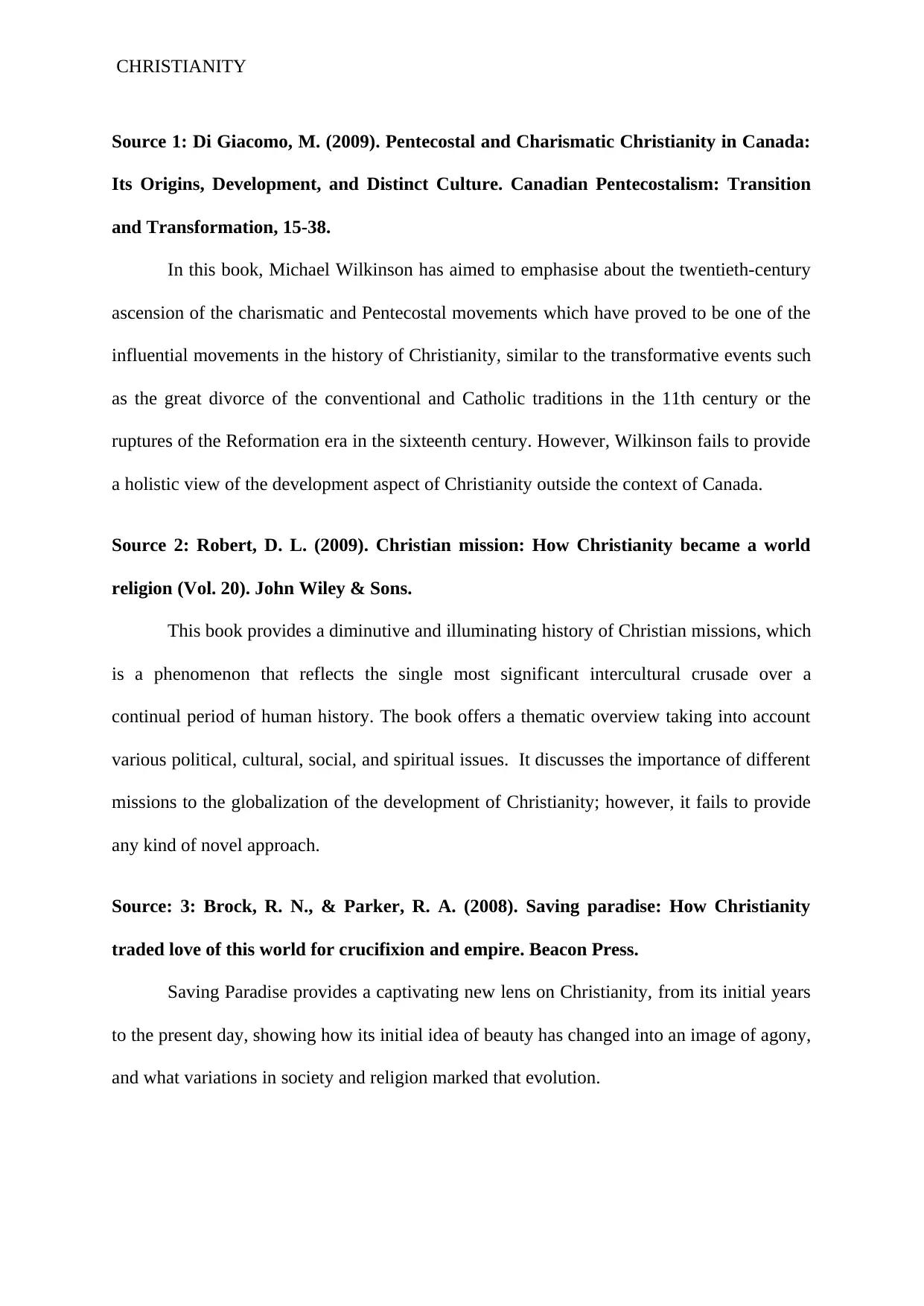
CHRISTIANITY
Source 1: Di Giacomo, M. (2009). Pentecostal and Charismatic Christianity in Canada:
Its Origins, Development, and Distinct Culture. Canadian Pentecostalism: Transition
and Transformation, 15-38.
In this book, Michael Wilkinson has aimed to emphasise about the twentieth-century
ascension of the charismatic and Pentecostal movements which have proved to be one of the
influential movements in the history of Christianity, similar to the transformative events such
as the great divorce of the conventional and Catholic traditions in the 11th century or the
ruptures of the Reformation era in the sixteenth century. However, Wilkinson fails to provide
a holistic view of the development aspect of Christianity outside the context of Canada.
Source 2: Robert, D. L. (2009). Christian mission: How Christianity became a world
religion (Vol. 20). John Wiley & Sons.
This book provides a diminutive and illuminating history of Christian missions, which
is a phenomenon that reflects the single most significant intercultural crusade over a
continual period of human history. The book offers a thematic overview taking into account
various political, cultural, social, and spiritual issues. It discusses the importance of different
missions to the globalization of the development of Christianity; however, it fails to provide
any kind of novel approach.
Source: 3: Brock, R. N., & Parker, R. A. (2008). Saving paradise: How Christianity
traded love of this world for crucifixion and empire. Beacon Press.
Saving Paradise provides a captivating new lens on Christianity, from its initial years
to the present day, showing how its initial idea of beauty has changed into an image of agony,
and what variations in society and religion marked that evolution.
Source 1: Di Giacomo, M. (2009). Pentecostal and Charismatic Christianity in Canada:
Its Origins, Development, and Distinct Culture. Canadian Pentecostalism: Transition
and Transformation, 15-38.
In this book, Michael Wilkinson has aimed to emphasise about the twentieth-century
ascension of the charismatic and Pentecostal movements which have proved to be one of the
influential movements in the history of Christianity, similar to the transformative events such
as the great divorce of the conventional and Catholic traditions in the 11th century or the
ruptures of the Reformation era in the sixteenth century. However, Wilkinson fails to provide
a holistic view of the development aspect of Christianity outside the context of Canada.
Source 2: Robert, D. L. (2009). Christian mission: How Christianity became a world
religion (Vol. 20). John Wiley & Sons.
This book provides a diminutive and illuminating history of Christian missions, which
is a phenomenon that reflects the single most significant intercultural crusade over a
continual period of human history. The book offers a thematic overview taking into account
various political, cultural, social, and spiritual issues. It discusses the importance of different
missions to the globalization of the development of Christianity; however, it fails to provide
any kind of novel approach.
Source: 3: Brock, R. N., & Parker, R. A. (2008). Saving paradise: How Christianity
traded love of this world for crucifixion and empire. Beacon Press.
Saving Paradise provides a captivating new lens on Christianity, from its initial years
to the present day, showing how its initial idea of beauty has changed into an image of agony,
and what variations in society and religion marked that evolution.
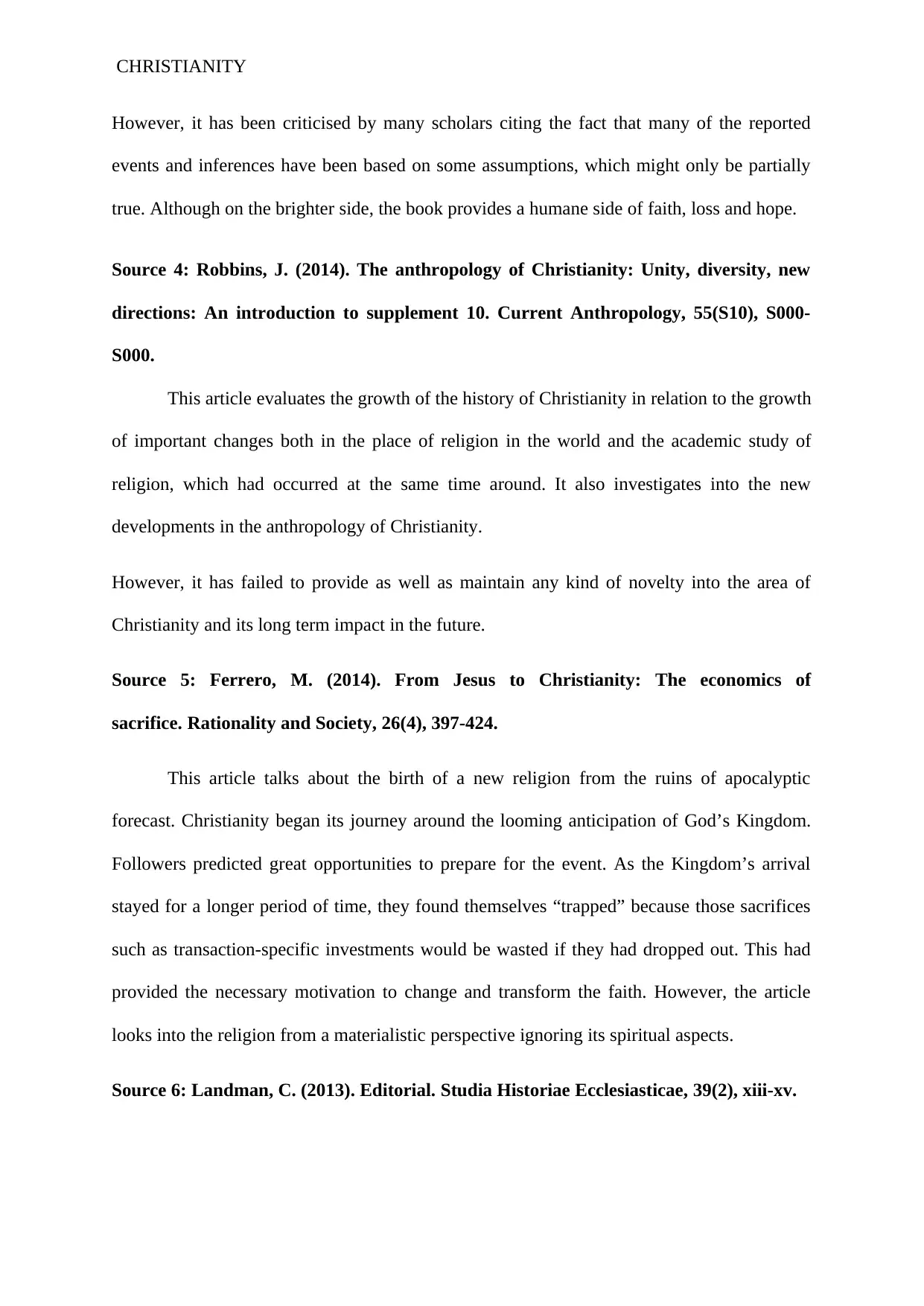
CHRISTIANITY
However, it has been criticised by many scholars citing the fact that many of the reported
events and inferences have been based on some assumptions, which might only be partially
true. Although on the brighter side, the book provides a humane side of faith, loss and hope.
Source 4: Robbins, J. (2014). The anthropology of Christianity: Unity, diversity, new
directions: An introduction to supplement 10. Current Anthropology, 55(S10), S000-
S000.
This article evaluates the growth of the history of Christianity in relation to the growth
of important changes both in the place of religion in the world and the academic study of
religion, which had occurred at the same time around. It also investigates into the new
developments in the anthropology of Christianity.
However, it has failed to provide as well as maintain any kind of novelty into the area of
Christianity and its long term impact in the future.
Source 5: Ferrero, M. (2014). From Jesus to Christianity: The economics of
sacrifice. Rationality and Society, 26(4), 397-424.
This article talks about the birth of a new religion from the ruins of apocalyptic
forecast. Christianity began its journey around the looming anticipation of God’s Kingdom.
Followers predicted great opportunities to prepare for the event. As the Kingdom’s arrival
stayed for a longer period of time, they found themselves “trapped” because those sacrifices
such as transaction-specific investments would be wasted if they had dropped out. This had
provided the necessary motivation to change and transform the faith. However, the article
looks into the religion from a materialistic perspective ignoring its spiritual aspects.
Source 6: Landman, C. (2013). Editorial. Studia Historiae Ecclesiasticae, 39(2), xiii-xv.
However, it has been criticised by many scholars citing the fact that many of the reported
events and inferences have been based on some assumptions, which might only be partially
true. Although on the brighter side, the book provides a humane side of faith, loss and hope.
Source 4: Robbins, J. (2014). The anthropology of Christianity: Unity, diversity, new
directions: An introduction to supplement 10. Current Anthropology, 55(S10), S000-
S000.
This article evaluates the growth of the history of Christianity in relation to the growth
of important changes both in the place of religion in the world and the academic study of
religion, which had occurred at the same time around. It also investigates into the new
developments in the anthropology of Christianity.
However, it has failed to provide as well as maintain any kind of novelty into the area of
Christianity and its long term impact in the future.
Source 5: Ferrero, M. (2014). From Jesus to Christianity: The economics of
sacrifice. Rationality and Society, 26(4), 397-424.
This article talks about the birth of a new religion from the ruins of apocalyptic
forecast. Christianity began its journey around the looming anticipation of God’s Kingdom.
Followers predicted great opportunities to prepare for the event. As the Kingdom’s arrival
stayed for a longer period of time, they found themselves “trapped” because those sacrifices
such as transaction-specific investments would be wasted if they had dropped out. This had
provided the necessary motivation to change and transform the faith. However, the article
looks into the religion from a materialistic perspective ignoring its spiritual aspects.
Source 6: Landman, C. (2013). Editorial. Studia Historiae Ecclesiasticae, 39(2), xiii-xv.
⊘ This is a preview!⊘
Do you want full access?
Subscribe today to unlock all pages.

Trusted by 1+ million students worldwide
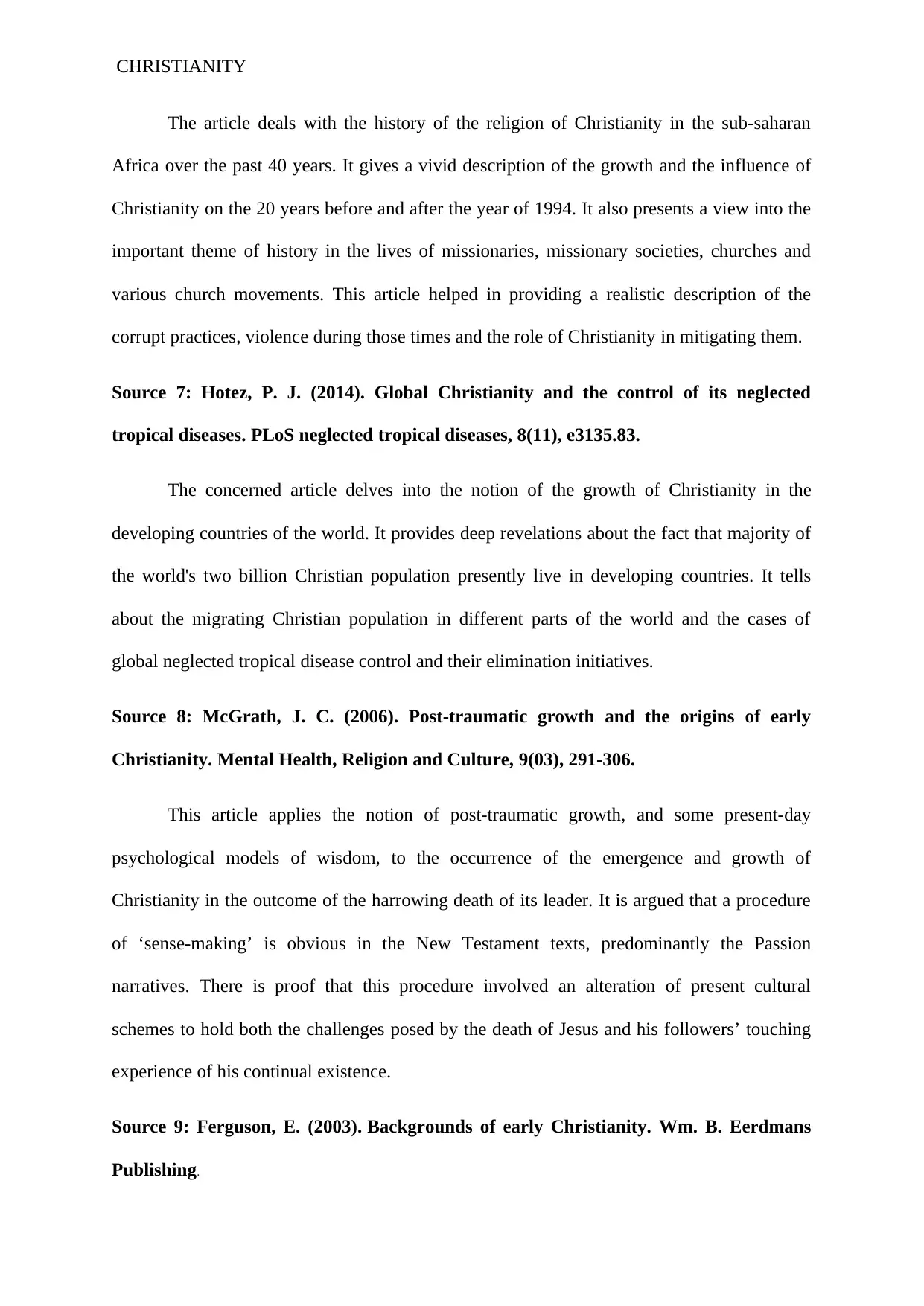
CHRISTIANITY
The article deals with the history of the religion of Christianity in the sub-saharan
Africa over the past 40 years. It gives a vivid description of the growth and the influence of
Christianity on the 20 years before and after the year of 1994. It also presents a view into the
important theme of history in the lives of missionaries, missionary societies, churches and
various church movements. This article helped in providing a realistic description of the
corrupt practices, violence during those times and the role of Christianity in mitigating them.
Source 7: Hotez, P. J. (2014). Global Christianity and the control of its neglected
tropical diseases. PLoS neglected tropical diseases, 8(11), e3135.83.
The concerned article delves into the notion of the growth of Christianity in the
developing countries of the world. It provides deep revelations about the fact that majority of
the world's two billion Christian population presently live in developing countries. It tells
about the migrating Christian population in different parts of the world and the cases of
global neglected tropical disease control and their elimination initiatives.
Source 8: McGrath, J. C. (2006). Post-traumatic growth and the origins of early
Christianity. Mental Health, Religion and Culture, 9(03), 291-306.
This article applies the notion of post-traumatic growth, and some present-day
psychological models of wisdom, to the occurrence of the emergence and growth of
Christianity in the outcome of the harrowing death of its leader. It is argued that a procedure
of ‘sense-making’ is obvious in the New Testament texts, predominantly the Passion
narratives. There is proof that this procedure involved an alteration of present cultural
schemes to hold both the challenges posed by the death of Jesus and his followers’ touching
experience of his continual existence.
Source 9: Ferguson, E. (2003). Backgrounds of early Christianity. Wm. B. Eerdmans
Publishing.
The article deals with the history of the religion of Christianity in the sub-saharan
Africa over the past 40 years. It gives a vivid description of the growth and the influence of
Christianity on the 20 years before and after the year of 1994. It also presents a view into the
important theme of history in the lives of missionaries, missionary societies, churches and
various church movements. This article helped in providing a realistic description of the
corrupt practices, violence during those times and the role of Christianity in mitigating them.
Source 7: Hotez, P. J. (2014). Global Christianity and the control of its neglected
tropical diseases. PLoS neglected tropical diseases, 8(11), e3135.83.
The concerned article delves into the notion of the growth of Christianity in the
developing countries of the world. It provides deep revelations about the fact that majority of
the world's two billion Christian population presently live in developing countries. It tells
about the migrating Christian population in different parts of the world and the cases of
global neglected tropical disease control and their elimination initiatives.
Source 8: McGrath, J. C. (2006). Post-traumatic growth and the origins of early
Christianity. Mental Health, Religion and Culture, 9(03), 291-306.
This article applies the notion of post-traumatic growth, and some present-day
psychological models of wisdom, to the occurrence of the emergence and growth of
Christianity in the outcome of the harrowing death of its leader. It is argued that a procedure
of ‘sense-making’ is obvious in the New Testament texts, predominantly the Passion
narratives. There is proof that this procedure involved an alteration of present cultural
schemes to hold both the challenges posed by the death of Jesus and his followers’ touching
experience of his continual existence.
Source 9: Ferguson, E. (2003). Backgrounds of early Christianity. Wm. B. Eerdmans
Publishing.
Paraphrase This Document
Need a fresh take? Get an instant paraphrase of this document with our AI Paraphraser
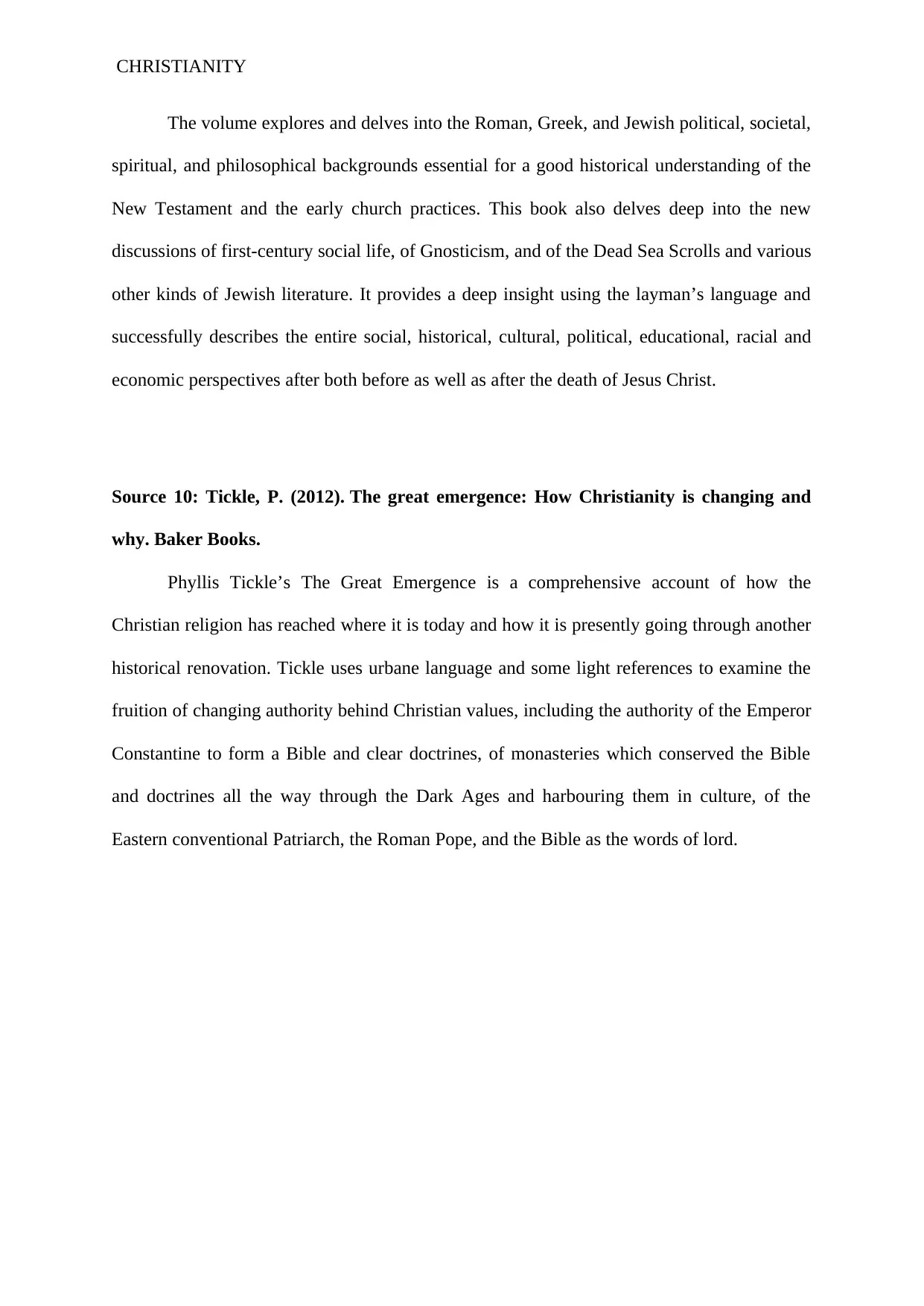
CHRISTIANITY
The volume explores and delves into the Roman, Greek, and Jewish political, societal,
spiritual, and philosophical backgrounds essential for a good historical understanding of the
New Testament and the early church practices. This book also delves deep into the new
discussions of first-century social life, of Gnosticism, and of the Dead Sea Scrolls and various
other kinds of Jewish literature. It provides a deep insight using the layman’s language and
successfully describes the entire social, historical, cultural, political, educational, racial and
economic perspectives after both before as well as after the death of Jesus Christ.
Source 10: Tickle, P. (2012). The great emergence: How Christianity is changing and
why. Baker Books.
Phyllis Tickle’s The Great Emergence is a comprehensive account of how the
Christian religion has reached where it is today and how it is presently going through another
historical renovation. Tickle uses urbane language and some light references to examine the
fruition of changing authority behind Christian values, including the authority of the Emperor
Constantine to form a Bible and clear doctrines, of monasteries which conserved the Bible
and doctrines all the way through the Dark Ages and harbouring them in culture, of the
Eastern conventional Patriarch, the Roman Pope, and the Bible as the words of lord.
The volume explores and delves into the Roman, Greek, and Jewish political, societal,
spiritual, and philosophical backgrounds essential for a good historical understanding of the
New Testament and the early church practices. This book also delves deep into the new
discussions of first-century social life, of Gnosticism, and of the Dead Sea Scrolls and various
other kinds of Jewish literature. It provides a deep insight using the layman’s language and
successfully describes the entire social, historical, cultural, political, educational, racial and
economic perspectives after both before as well as after the death of Jesus Christ.
Source 10: Tickle, P. (2012). The great emergence: How Christianity is changing and
why. Baker Books.
Phyllis Tickle’s The Great Emergence is a comprehensive account of how the
Christian religion has reached where it is today and how it is presently going through another
historical renovation. Tickle uses urbane language and some light references to examine the
fruition of changing authority behind Christian values, including the authority of the Emperor
Constantine to form a Bible and clear doctrines, of monasteries which conserved the Bible
and doctrines all the way through the Dark Ages and harbouring them in culture, of the
Eastern conventional Patriarch, the Roman Pope, and the Bible as the words of lord.
1 out of 5
Your All-in-One AI-Powered Toolkit for Academic Success.
+13062052269
info@desklib.com
Available 24*7 on WhatsApp / Email
![[object Object]](/_next/static/media/star-bottom.7253800d.svg)
Unlock your academic potential
Copyright © 2020–2025 A2Z Services. All Rights Reserved. Developed and managed by ZUCOL.